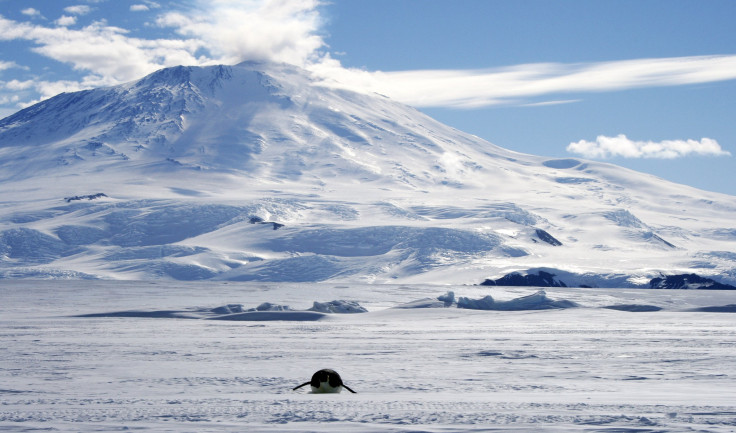Global Warming Dictating US Defense Strategy? How Climate Change Is Spurring The New 'Arctic Strategy' [Maps]

President Barack Obama’s national security strategy, which takes into account climate change in the newly opened Arctic region, just got a step closer to implementation, as Secretary of Defense Chuck Hagel announced the Pentagon’s new Arctic Strategy.
“The Arctic is at a crucial point in its transformation from a relatively isolated region to one where receding ice is enabling increased human access,” Hagel said in a statement. “As climate change and the viability of new energy sources shape the global environment, these shifts will affect our strategic outlook going forward, especially in the Arctic.”
The strategy, released Friday, builds on President Obama’s new National Strategy for the Arctic Region, announced in May.
The Arctic region is the land and sea area north of the Arctic Circle. The United States, because of Alaska, is an Arctic country. The four other Arctic coastal states are Canada, Russia, Norway and Denmark's vast autonomous territory of Greenland.

Today, the region has become increasingly important as new sea lanes have opened during Arctic summers, thanks to record high temperatures, which melt the sea ice.
Between March and September 2012, 4.57 million square miles of Arctic sea ice melted. In fact, the polar ice cap today is 40 percent smaller than it was in 1979, and the environmental changes are attributed to climate change.
“Record low extents of Arctic sea ice over the past decade have focused scientific and policy attention on links to global climate change and projected ice-free seasons in the Arctic within decades,” a Congressional Research Service report stated in August. “These changes have potential consequences for weather in the United States, access to mineral and biological resources in the Arctic, the economies and cultures of peoples in the region, and national security.”
Speaking at the Halifax International Security Forum in Canada, Hagel said the Arctic needs to be secure and stable where U.S. “national interests are safeguarded, the U.S. homeland is protected, and nations work cooperatively to address challenges.”
The development of Arctic oil and gas is part of a “broader energy security strategy, including our economic, environmental and climate policy objectives,” according to the May 2013 White House document.
Obama’s May 2013 National Strategy for Arctic Region built on a 2009 national security directive issued at the end of the Bush administration, which, among other points, discussed “national security and homeland security interests in the Arctic.” The directive established a new U.S. policy for the Arctic region.
In 2010 Obama’s National Security Strategy outlined the U.S. interests in the Arctic.
“The United States is an Arctic nation with broad and fundamental interests in the Arctic region, where we seek to meet our national security needs, protect the environment, responsibly manage resources, account for indigenous communities, support scientific research, and strengthen international cooperation on a wide range of issues,” according to the 2010 strategy.

The DoD’s new strategy follows Obama’s ambitious goal to slash U.S. greenhouse gas output by 17 percent (compared to 2005 levels) by 2020.
“We are beginning to think about and plan for how our Naval fleet and other capabilities and assets will need to adapt to the evolving shifts and requirements in the region,” Hagel
The United States has a national interest in preserving all of the rights, freedoms, and uses of the sea and airspace recognized under international law. The Department will preserve the global mobility of United States military and civilian vessels and aircraft throughout the Arctic, including through the exercise of the Freedom of Navigation program to challenge excessive maritime claims asserted by other Arctic States when necessary.

Here are some of the consequences of the Arctic's sea ice melting, according to U.S. Coast Guard:
* Shipping and transit increased by 118 percent through the Bering Strait from 2008 to 2012
* 1 million tourists now may visit the region in 2013
* 1 million tons of cargo were shipped in 2012 through the region
The Arctic Ocean and its floor are rich in natural resources, and the Arctic countries are vying for a stake in the abundance of crude oil, natural gas and various minerals located there.
The region holds approximately 12 percent of the world’s undiscovered oil reserves and 30 percent of its undiscovered natural gas and natural gas liquids. It also holds $1 trillion worth of minerals, such as nickel and zinc.
Since 2005, $3.7 billion in commercial investments have been made in offshore leases, and the amount of exploration and investment in the region is likely to rise as ice continues to melt. But the melting ice and opening of sea lanes could destabilize the Arctic region as countries like the U.S. and Russia may dispute claims to sea areas that were unreachable before.
© Copyright IBTimes 2024. All rights reserved.






















